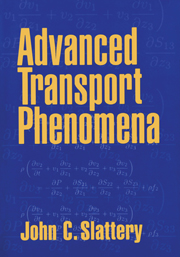Book contents
- Frontmatter
- Contents
- Preface
- List of Notation
- Advanced Transport Phenomena
- 1 Kinematics
- 2 Foundations for Momentum Transfer
- 3 Differential Balances in Momentum Transfer
- 4 Integral Averaging in Momentum Transfer
- 5 Foundations for Energy Transfer
- 6 Differential Balances in Energy Transfer
- 7 Integral Averaging in Energy Transfer
- 8 Foundations for Mass Transfer
- 9 Differential Balances in Mass Transfer
- 10 Integral Averaging in Mass Transfer
- A Tensor Analysis
- B More on the Transport Theorem
- References
- Author/Editor Index
- Index
4 - Integral Averaging in Momentum Transfer
Published online by Cambridge University Press: 05 June 2012
- Frontmatter
- Contents
- Preface
- List of Notation
- Advanced Transport Phenomena
- 1 Kinematics
- 2 Foundations for Momentum Transfer
- 3 Differential Balances in Momentum Transfer
- 4 Integral Averaging in Momentum Transfer
- 5 Foundations for Energy Transfer
- 6 Differential Balances in Energy Transfer
- 7 Integral Averaging in Energy Transfer
- 8 Foundations for Mass Transfer
- 9 Differential Balances in Mass Transfer
- 10 Integral Averaging in Mass Transfer
- A Tensor Analysis
- B More on the Transport Theorem
- References
- Author/Editor Index
- Index
Summary
I mentioned in my introduction to Chapter 3 that not every interesting problem should be attacked by directly solving the differential mass and momentum balances. Some problems are really too difficult to be solved in this manner. In other cases, the amount of effort required for such a solution is not justified, when the end purpose for which the solution is being developed is taken into account.
In the majority of momentum transfer problems, the quantity of ultimate interest is an integral. Perhaps it is an average velocity, a volume flow rate, or a force on a surface. This suggested that I set aside an entire chapter in order to exploit approaches to problems in which the independent variables are integrals or integral averages.
I begin by approaching turbulence in terms of time-averaged variables. Then I look at some problems that are normally explained in terms of area-averaged variables. The random geometry encountered in flow through porous media suggests the use of a local volume-averaged variable. The chapter concludes with the relatively well-known integral balances for arbitrary systems.
Again I encourage those of you who feel you are primarily interested in energy and mass transfer to pay close attention to this chapter. The ideas developed here are taken over, almost without change, and applied to energy transfer in Chapter 7 and to mass transfer in Chapter 10.
Time Averaging
The most common example of time averaging is in the context of turbulence. Turbulence is defined to be a motion that varies randomly with time over at least a portion of the flow field such that statistically distinct average values can be discerned.
- Type
- Chapter
- Information
- Advanced Transport Phenomena , pp. 182 - 249Publisher: Cambridge University PressPrint publication year: 1999



